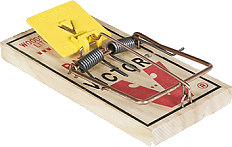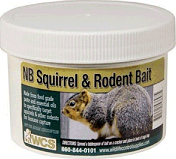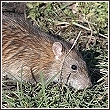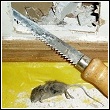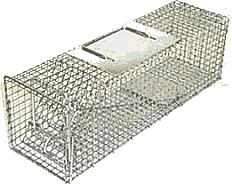- Order your traps from the links in this paragraph, or on down the page. Most people choose to use the Victor Lethal Kill mouse and rat traps or the non-lethal Safeguard rat and mouse trap.
- Order NB Squirrel and Rodent Bait which can be purchased online through the link provided here.
-
Pre-bait in the area or areas you plan to place your traps with 1/8 cup of peanut butter to train them to come to that area.
Professional traps and bait will take a week to arrive, so if they eat all of the peanut butter you placed out within that time frame, put down more.

- Traps and bait arrive!
- Take your kitchen knife and stir the squirrel and rodent bait to mix it up. Do not use a spoon because it smells yummy and you will be more tempted to eat it with a spoon in your hand! Use the knife to properly bait the trap as directed (see below).
- You win! You caught rats & mice! Put gloves on and remove the unwelcome rodent.
- Call us to seal up your house so it doesn't happen again.
Trapping Rodents
The Wildlife Whisperer, Inc. does not advocate needles trapping of wildlife, however, due to their nature, it is sometimes necessary to use trapping methods to get rid of rodents such as rats and mice.
Getting rid of rodents can often be taken care of by the homeowner without calling for professional help - as long as they utilize the most effective methods. Otherwise, their efforts may not be successful.
We have prepared some information for you regarding trapping rodents. If you decide you would like to use a professional, we can certainly help, we know how to get rid of rats and mice.
Getting Rid Of Mice And Rats Fast
Most people who contact us regarding rodents want to save money by trapping mice and rats on their own, and then allow us to do what we do best, which is to alter their building to keep mice and rats out forever.
There are lots of choices when it comes to various methods for getting rid of rodents. If you would like comprehensive information on this topic please read this page thoroughly from top to bottom.
However, if you want to take the fast track, a track where you take care of some of the process yourself, then leave the finishing details to us, please see the following step by step instructions below:
Choosing Whether Or
Not To Use Traps
The Wildlife Whisperer, Inc. does not believe in needless trapping. One of the things that we rely on to avoid using traps is the fact that most wildlife will occasionally exit the home they are living in.
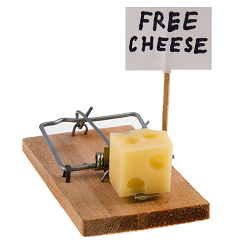
However, mice and rats are often the exception to this rule, rodents that have lived their entire lives inside a house seldom leave. If rodents have an indoor food source, there is no reason for them to leave the building. If mice and rats do not enter and exit the building on a daily basis, we cannot ask them to do so like the Pied Piper, therefore trapping is mandated in such rodent related circumstances.
In other words, sometimes setting traps to remove these freeloaders will be the only way to get rid of your rodents. Once our rodent-proofing repairs have been completed, your home should be sealed preventing future issues ... that is unless you leave your doors or windows open.
We want to treat your pocketbook as if it is our own. 99% of our rat and mouse clients have chosen to take care of their own interior rodent trapping because it is much more cost effective for them, vs. paying us to come and check traps twice a day and having to plan ahead to meet daily at your home. We can easily instruct anybody on how to properly bait and set traps. Having you pay us, or a trapping service to repeatedly trap your mice and rats can get needlessly expensive.
When problems arise, using the right traps will be important to the success of your project, waiting the extra time for professional traps and lures to be shipped to you from CT will be well worth your time and while. The cost of the below professional rodent traps can rid your home of mice - just like the pros would do, for a fraction of the cost.
Because you are human, you will occasionally leave the garage, door or screenless window open and end up with some rats or mice back in your house... but, you will now have the traps to remove them properly. We recommend purchasing a variety of traps. You may find that a friend had great results with one trap, but you do not.
Different rodent bait and rodent trap combinations can empty your house of the furry squatters quickly. Mouse and rat trap baiting instructions are found below, but if further assistance is desired, do not hesitate to call or ask your Skunk Whisperer® Wildlife Management Professional when he or she is at your home.
Trapping Safety & Baiting
Although we do not advocate the use of lethal mouse traps and rat traps for a plethora of reasons, we have included information on both live and lethal professional mouse and rat traps to assist in your decision.
Should you choose to pursue the trapping method, you will need disposable gloves, bait and traps.
Pre-baiting And Making Trapping Efforts More Successful
Rats are neophobic which means they are afraid of "new" things - like traps, or the food in the traps. Sometimes a rat will even take a small bite of a new food and wait to see if it makes them sick before they eat any more. One of the ways you can increase your chances of success with trapping rodents around your property is to pre-bait the area for a while first. A good time to do this is while you are waiting for your professional trap and rodent lures to arrive. This will help you get rid of rodents much faster once your traps are delivered. If you have a problem in the attic, for example, find a convenient place to smear peanut butter and mixed nuts. Allowing the mice and rats to eat this free food may seem counter-productive, but this important time saving step will have them pre-trained to come to that convenient area and hop into your traps much faster.
Safety & Disposable Gloves
Always wear disposable plastic gloves when handling traps. From the moment you take the traps out of the packages they came in, do not touch the traps with your bare hands. Your scent can deter any rodents from hopping into your trap. Human scent transfer and germ transfer are a dual concern when trapping animals, and disposable gloves help prevent both.
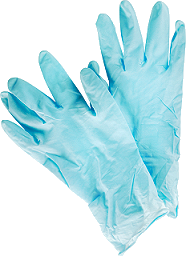
You can buy traditional latex gloves online or at wildlife control stores.
Rat & Mouse Lures
When baiting live traps take a tablespoon or two of the proper professional lure and place it behind the "pan" (the part that sets the trap off and makes it close. Always stir well and never eat the bait yourself no matter how yummy it smells. Some of the popular baits include:
- Kirk's Gold Magic - a gel bait with smell to attract mice & rats
- NB Squirrel & Rodent Paste Bait - a professional paste that smells like food
- WCS Fruit and Nut Squirrel and Rodent Lure - a syrupy, semi-thick liquid attractive to rodents
Using Your Pet's Food
To An Advantage
Rodents can steal and store incredible amounts of pet food. Cutting off their food source immediately is mandatory. There is no reason for them to hop in a trap with pet food if they have a bunch of it stored up in the wall or under the cabinets. If you are feeding pets outdoors - stop. However, if the troublesome mice or rats around your home have been making the most of your pet's food source, this can actually work to your advantage.
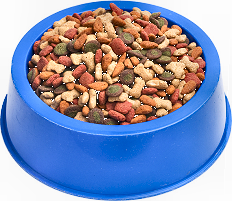
All wildlife wants is food, water and shelter. If you have been free feeding your pet, leaving their food out all day long, the nuisance rodent has probably grown used to feasting on it themselves as well.
One of the first things you'll have to do is stop the 24 hour food source - retrain your pet to eat at specific times only, even if only temporarily until your rodent problem is solved.
But this will also make it easier to catch the troublesome rodent. Here's how to accomplish both tasks at the same time. Place food in your pet's bowl and after 15 minutes, cover it up with three dinner plates. This will do two things: train your pet to eat right away, and the weight of the plates will not allow rats or mice to access the food. Because the rodents are likely eating your pet food, trapping now is simplified - simply place your rodent traps right next to the covered food and use pet food as bait. Voila! The rodents are virtually trained to go to the traps! Use of live traps is very important with this method - nobody wants to see their pet with a painful snap trap on their nose!
Live & Non Lethal Trapping
Live traps are often an option for home and property owners who do not wish to use poisons or lethal kill methods. However, it always important to follow proper safety procedures from start to finish (as outlined above), particularly when handling baits, setting traps and releasing rodents.
You will also want to make sure you select the right trap for the animal in question. For instance, most mouse traps will be too small to catch rats.
In contrast, there can also be times when a trap for one kind of animal may work for another. For example, the "Special Squirrel Trap" can be more effective against larger rats than rat specific traps. This is because rats are sometimes less fearful of certain types of squirrel traps than they are of those designed specifically for them.
It is important to know that some traps are designed as "single catch" for catching one rodent at a time, requiring them to be emptied after each catch, and others, i.e., multi catch, are designed to trap multiple rodents in a repeating manner without being reset between each catch.
The Safeguard Brand
Non-Lethal Rat & Mouse Traps
Safeguard single and multi catch rat and mouse traps are well made and they can be very effective when it comes to capturing live rodents.
Safeguard Single Catch
Mouse & Rat Trap
The galvanized steel "Single Catch" rodent trap, has a rear door for easy bait and removal, and is designed to catch one rodent at a time.
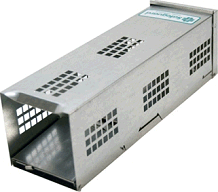
by Safeguard
Follow the instructions for setting and adjusting the trap. This trap is worth the extra trouble and expense. If you expect to live capture rats or larger mice, this live trap is the best one for you for the price in our opinion.
The Single Catch Safeguard
Rat And Mouse Traps
Check Spring Before Use
During shipping, the Safe Guard single catch live mouse and rat trap spring may have shifted. Open the trap and inspect it. Be certain that both ends of the spring are under the back plate, allowing the pan to spring up a little bit. If they are not, the trap will not work. You will need to use a tweezers to pull the spring under the pan again because it may have moved in shipping. Be certain that the lure does not go under the pan on this trap. If lure gets under the pan, the trap will not close on the animal and trap it. Once you have baited this trap, take a piece of duct tape and secure the back door with it just in case you end up with a super-feisty rodent - you don't want them to get out until you empty the trap.
Safeguard "Repeating" Multi Catch Mouse Traps
Safeguard also makes a multi-catch mouse trap with a plastic viewing window. You can buy it by individual trap or as a case of 12.
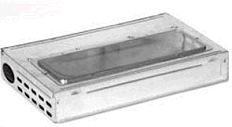
by Safeguard
Any Multi Catch Live Traps
Single Catch For Rats and Flying Squirrels
Please know that repeating live mouse traps will not capture flying squirrels or rats because the traps are too small for them to enter.
Baiting Single Catch Traps
Place the lure in the middle of the trap, directly on the floor of the trap. Do not place the lure on a cracker as it may slide under the door mechanism, allowing the mice to exit or making it so others cannot enter.
Squirrel Traps For Rats
The very best live trap for capturing roof, Norway and pack rats is the "The Special Squirrel Trap " from WCS.
This is a high quality professional trap that catches even smaller rats, and does not allow them to escape though the smaller mesh size.
This squirrel trap is a simple, inexpensive live trap worth it's weight in gold when you have rats too large or too scared to step into the single catch Safeguard rodent traps.
Baiting The WCS Special Squirrel Trap
Using a white makeup application pad (the same kind used for eye appeal), scoop a tablespoon of their WCS NB Squirrel and rodent paste bait and place it behind the pan and trigger, but not on the pan. Voila, you are a rat removal expert!
With a little practice, these live traps can be set with a hair trigger and take care of removing your rats quickly.
Other Non-Lethal Live Mouse Traps
There are several innovative traps available that are designed for the catch and release of mice without having to touch, kill or handle them.
- Tin Cat - a professional repeating trap (with or without window, single or by the case)
- Corner Cat - a diamond shaped professional repeating mouse trap for corner areas
- Tip Trap Live Capture - a rocking based trap with weight shift locking mechanism

Cube and Tip Traps:
Use a butter knife to place lure as far towards the back of the trap as possible. Be certain to set the trap in a place which will not allow an aggressive mouse to tip the trap on it's side, allowing it to escape.
Releasing The Mice You Catch
It is very important to have your house properly sealed up before you release any rats or mice you catch in your non-lethal traps or they will most likely come right back in. However, if your house is sealed up first, before you release the rodents, you will have a better chance of preventing reinfestation. Once the Wildlife Whisperer's effective rodent-proofing repairs have been completed, simply releasing the trapped mice and rats right on your back porch, will prove to you that we have succeeded in properly sealing up your home.
Lethal Traps
Victor Lethal Kill Traps
For Rats And Mice
We do not advocate lethal trap use for a plethora of reasons. For example, if you catch a rodent on the tail or foot and it is unable to chew it's tail or foot off but it can still crawl around, you may end up with a rodent crawling into and becoming trapped in a wall, half way to the floor. This makes dead rodent removal more difficult and costly.
If you insist on using mouse kill traps, do it right with professional traps that will be more likely to procure a quicker, more humane, less painful death. Get the professional traps and lures.
Why would we instruct you on how to use kill traps? Because if you insist on using lethal traps for rats, mice, or other wildlife, we insist on trying to make sure that your kills are as humane as possible.
Note the large yellow plastic triggers (pans) on them. Take a small amount of professional lure and place it on the underside of the yellow trigger. The lure should be no thicker on the bottom of the trigger than the depth/height of a dime. This thin layer on the underside of the trigger (A.K.A. "pan") will force the mice to "work at it", therefore causing them to set off the traps much quicker than simply placing the lure on top of the pan for them to steal without tripping the pan. Traps should be placed no closer together than 1½ foot. Traps should be perpendicular to walls with the big square yellow pan closest to the wall. The professional lethal traps have sensitivity adjustments on them. Count traps when you set them. Rodents can get parts of their bodies caught in a trap and become lodged inside your walls, forcing us to cut out dead, rotting animals in hard to reach areas that mandate destruction to get to. If disposing of each trap with a mouse in it, simply grab the trap with gloved hands, pulling the glove off your hand and over the trap in one motion.
- Lethal Mouse Trap - designed for professional use with a larger surface area
- Lethal Rat Trap - professional traps designed for either home or industrial use
1242 SW Pine Island Rd., Suite 310
Cape Coral, Florida 33991-2126
help@totalwildlifecontrol.com



